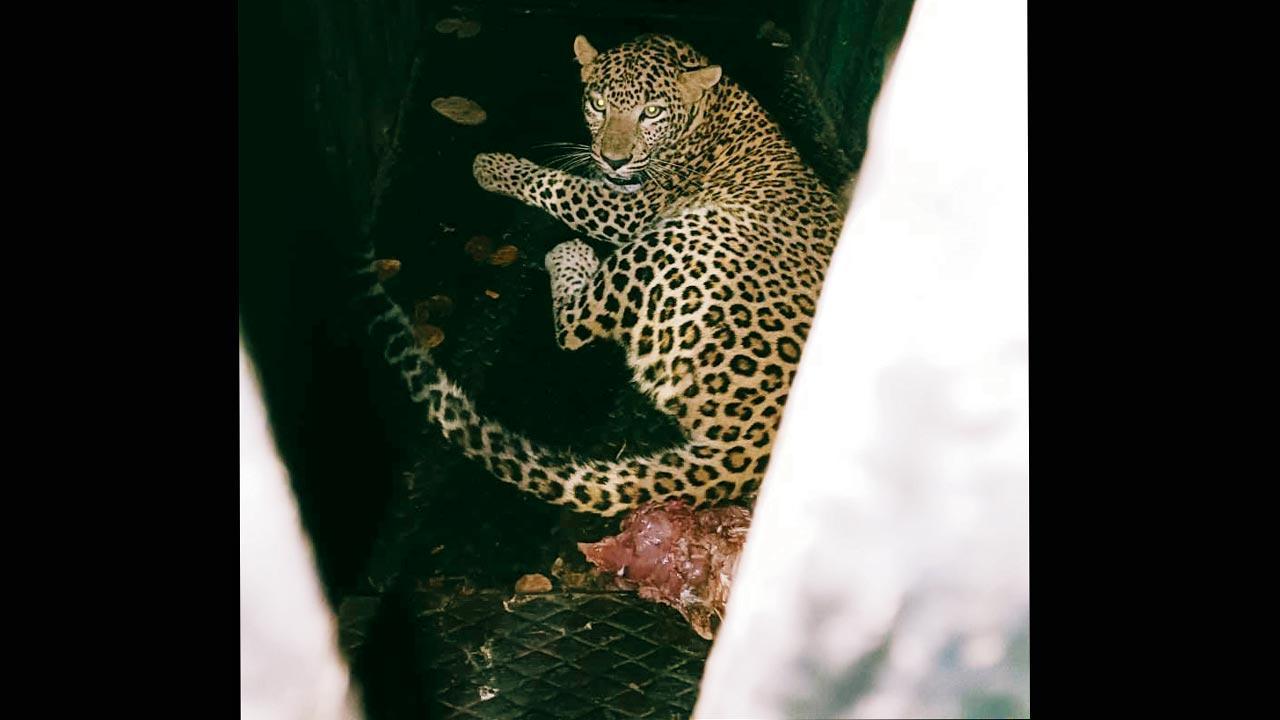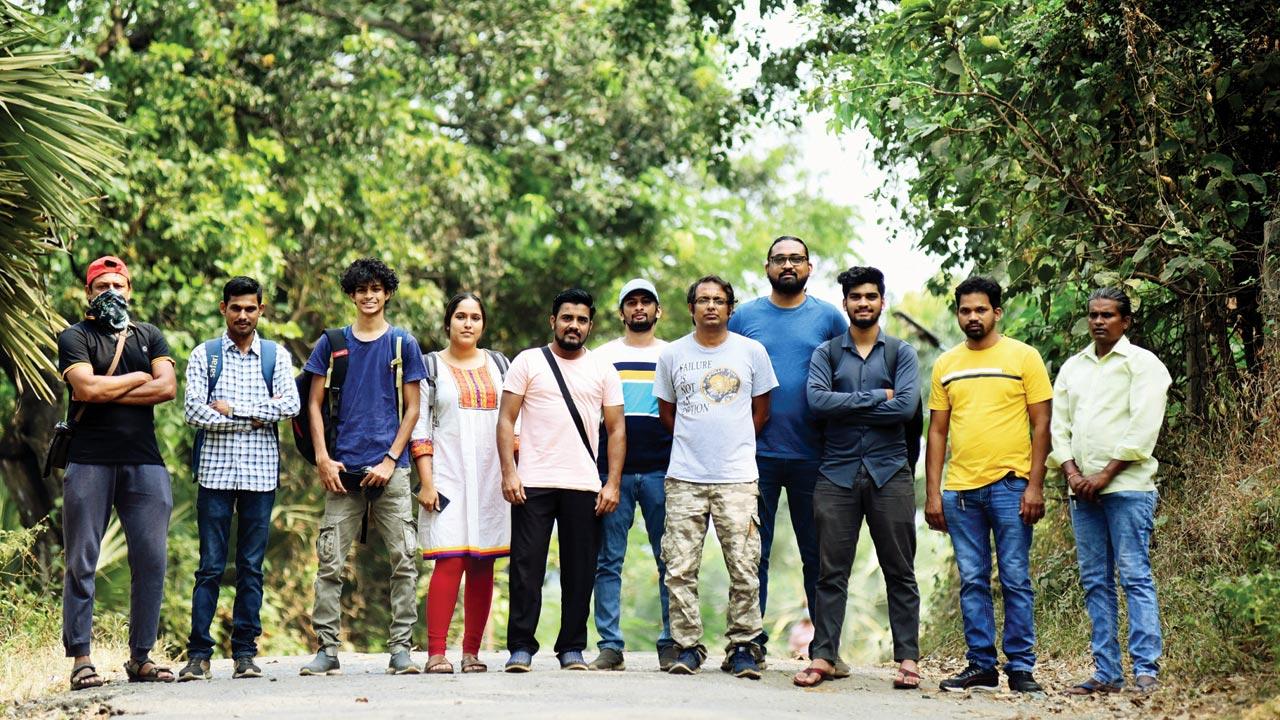mid-day spends morning after mischievous Aarey leopard was trapped, with team that laboured for a month to solve man-animal conflict

The captive C32 is said to be a female sub-adult. In human age, it equals the early teens, says Mayur Kamath, honorary wildlife warden of Mumbai suburbs, who helmed the operation
On October 31, when the permission to conduct an operation to capture female leopard C32 lapsed, Mayur Kamath, honorary wildlife warden of Mumbai suburbs, knew they would have to hurry to get the approval extended. Permissions are usually granted for a month, according to the rule of the State Forest Department. It had been 33 days. A go-ahead had to come from the principal chief conservator of forest (PCCF) in Nagpur.
ADVERTISEMENT
Since August 31, nine people including a four-year-old boy had been injured in leopard attacks, while several others had claimed that a big cat had charged at them. C32 had begun displaying traits similar to a suspected ‘man-eater’ from 2017, and this was a development that had left Kamath and his team on tenterhooks. “It was a ticking time bomb. The animal had become extremely bold. There were pictures of her moving around in human settlements post sunrise and early sundown. Such behaviour is disastrous for the animal itself because [at those hours] there are people around.” According to the naturalist, if an animal has to survive in a human-dominated landscape like Goregaon’s Aarey Milk Colony, it needs to alter its biological timings such that it ventures out when humans are not around. “Most animals respect human boundaries and wait till it gets dark to move about. This reduces the possibility of human-animal conflict.”
 (Left to right) Volunteers Imran Udat, Kaushal Dubey, Daniel Miranda, Vanishree Naik, Wasim Athaniya, Ashutosh, Mayur Kamath, Kunal Chaudhari, Raj Jadhav, Hitendra Pachkale and Pradeep Dalvi were part of the larger team that worked in shifts 24/7 leading up to C32’s trapping. Pics/Sameer Markande
(Left to right) Volunteers Imran Udat, Kaushal Dubey, Daniel Miranda, Vanishree Naik, Wasim Athaniya, Ashutosh, Mayur Kamath, Kunal Chaudhari, Raj Jadhav, Hitendra Pachkale and Pradeep Dalvi were part of the larger team that worked in shifts 24/7 leading up to C32’s trapping. Pics/Sameer Markande
But, C32 was no ordinary cat. Sharp and astute, the sub-adult had sent the wildlife authorities and Aarey volunteers on a wild goose chase. Strategies to capture truant animals that had worked in the past were failing this time. The first female leopard that walked into a cage turned out to be the sibling of C32 and continues to be in captivity. Two other leopards that were trapped were released into their natural habitat as their rosette pattern did not match with C32. “C32 was smart. She would walk around the cage and sometimes, even side-step the padding. The animal needs to step on the padding for the door to fall behind it. She’d roam around in the bait trap and the larger cage that it was housed in, and step out without disturbing the mechanism,” Kamath explains.
But luck ran out for her on the evening of November 3, when she walked into the trap set up near Unit 31, close to Ekta Nagar. Deputy Conservator of Forest (DCF) Gajendra Hire and Assistant Conservator of Forest (ACF) Girija Desai from the Thane Forest Department (Territorial) along with the Rapid Rescue Team from Thane and Sanjay Gandhi National Park (SGNP) and Mumbakairs for SGNP, involving members of the civil society, were all on the job. A total of eight cages had been made active in Aarey Milk Colony since October 1.
 Mayur Kamath
Mayur Kamath
On the day of the final capture, the team had devised a new game plan, for the umpteenth time. “When an animal enters a human-dominated landscape, it also needs a way to find a hiding place,” says Kamath. Taking off from this, the team decided to separate the bait cage from the trap cage. “I wanted the animal to make a mistake. So, we kept the trap cage away, hidden in the tall grass, with a piece of meat placed inside it. In its attempt to run for cover after taking the meat, it entered the trap cage. That’s how we caught it,” explains Kamath, adding that it’s most likely to be kept in captivity. “People have to realise that these animals can’t be released deep into the forest because they have been taught [by their mothers] to prey on animals that are around human settlements such as dogs, chickens, and pigs. They won’t be able to bring down a wild hare or deer.”
Sunil Limaye, the Principal Chief Conservator of Forest, says what made the task challenging was Aarey’s landscape. “While it has a good forest cover, it also has a high density of people. The terrain is a mix of forest, grassland and small hillocks, which made the operation difficult to execute. There was also the presence of other leopards who were using the same trail as C32. So, the forest department team along with researchers and volunteers had to work in shifts 24/7 to make the operation successful,” he says. The ongoing camera trapping exercise in Aarey Milk Colony, with footage collected over the past five years, proved crucial by providing data to identify the suspected leopard. During this camera trapping exercise, the team learnt that Bianca, one of the leopards roaming the area, had cubs. Care was taken to ensure that she didn’t get trapped since that would be disastrous, resulting in the natural death of the cubs or them being killed by other leopards in the absence of their mother.
 Kunal Chaudhari
Kunal Chaudhari
Documentary filmmaker Kunal Chaudhari, who was part of the volunteer team, says he and fellow members have seen the evolution of C32 since she was a cub. “It’s difficult to zero in on one reason why she began attacking humans. If you see her [attack] pattern, she hasn’t killed anyone. She’s not a ‘man-eater’ because no human death has occurred on her account. But the leopard’s behaviour and the resultant attacks had made the residents of Aarey so angry that we were worried they would end up harming the animal, or any other unsuspecting leopard. They’d often tell the forest department officials, if you are not able to capture the leopard, we’ll take over. The trouble is a layman can’t tell which leopard is responsible. For them, all leopards are the same.”
The data that the team had collected through camera traps helped them identify C32’s parentage, her rosette pattern and movements. So when the attacks began to take place, Chaudhari says they already had sound material to draw references from. According to him, C32’s main “hangout” was the area around Chotta Kashmir, a popular tourist attraction in the city and venue for movie shoots. “We had requested the temporary closure of the garden for five days. After that, entry was allowed only between 9 am and 4 pm because we didn’t want the animal to be disturbed. There are at least 600 tourists thronging the gardens daily on weekends,” he says. Chaudhari, along with volunteers, had to conduct awareness campaigns to ensure that locals didn’t frequent these spots post sundown and that no child, stray dog or pet animal accidentally entered the traps set up for the animal. Each team was assigned specific duties. The cages would be set up at 6 am every day and deactivated and dismantled at 5 am the following morning. Kamath says these aren’t ordinary cages and each weighs close to 150 kg. “There was live monitoring to track the leopard’s movements. We’d sit in the night in the makeshift station and observe how the animal is behaving around the cage. This went on for a month.”
Chaudhari says most members of the team had suspended their lives and focussed on this effort. “Our families knew that there would be no festival that would take precedence over this mission. It wasn’t a compulsion. After five years of assisting with leopard conservation, it felt like a personal responsibility for all of us.”
09
No. of people, including a four-year-old boy, who had been injured in leopard attacks since August 31
33
No. of days that the operation to capture the leopard lasted
150
Weight in kg of the trap cages set up in Aarey
C32’s hitlist
. Sept 2- Pintu Pandit suffered injuries after an attack near Unit 32.
. Sept 18- A big cat pounced on Rohit Tilak Bahadur, 10, near unit 31.
. September 26- Leopard attacked Ayush Yadav, 3, at Unit 3.
. Sept 29- Senior citizen Nirmal Singh was attacked near Visawa.
.Sept 30- Rajesh Rawat was attacked near Sunil Maidan.
. Oct 8- Darshan Satish Kumar, 14, was attacked at Unit 13 in Aarey
. Oct 24- Balwant Yadav was attacked near Unit 31
 Subscribe today by clicking the link and stay updated with the latest news!" Click here!
Subscribe today by clicking the link and stay updated with the latest news!" Click here!







